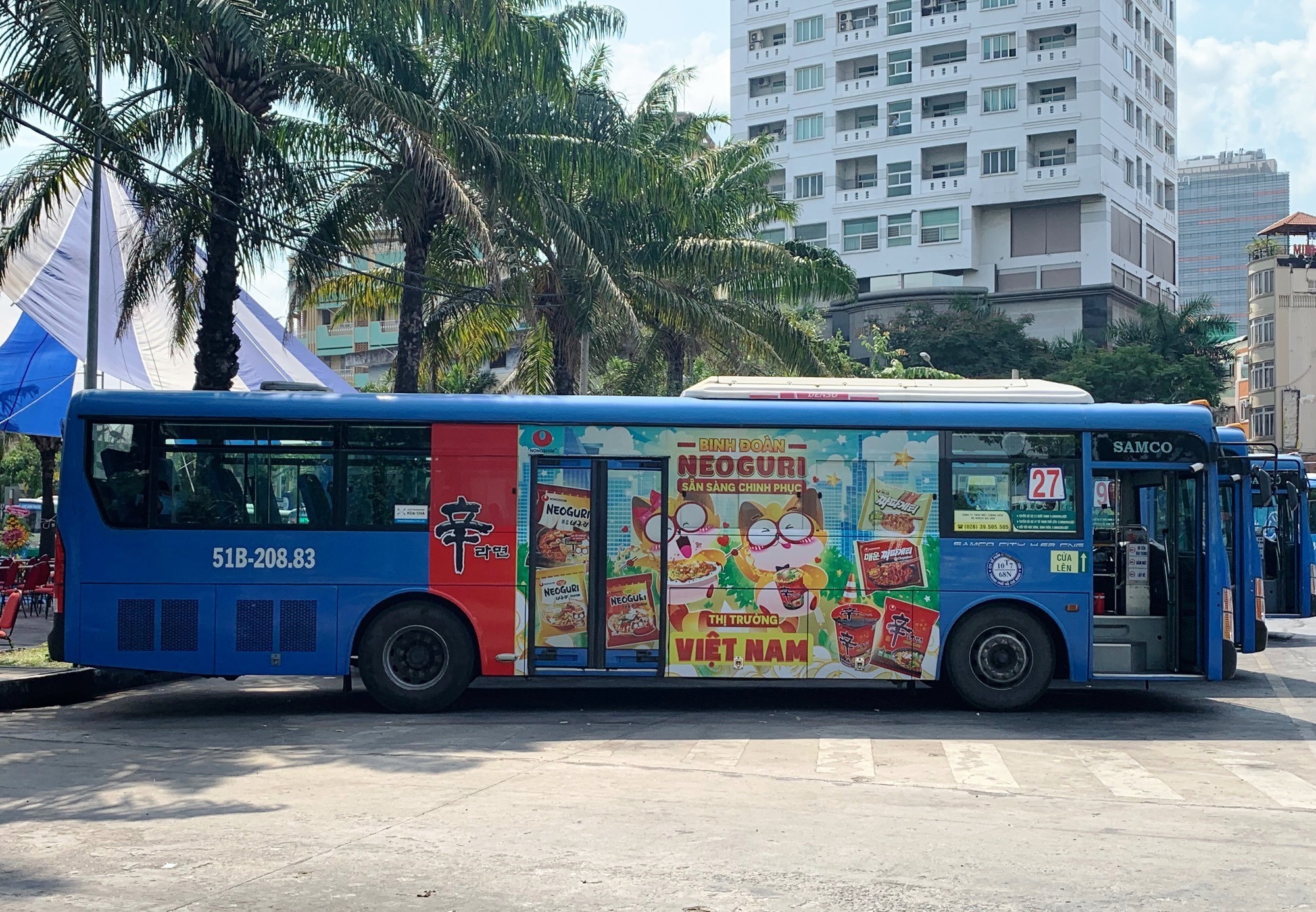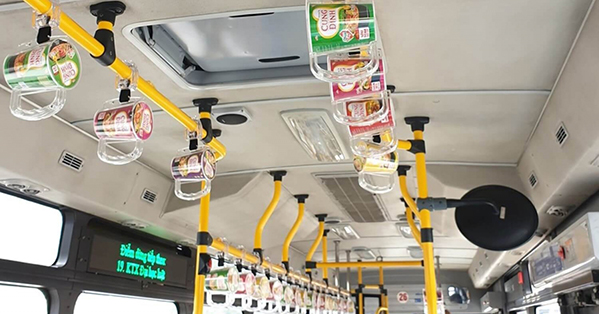Tindi is a leading provider of nationwide bus advertising services, offering quick implementation and attractive pricing with many special offers.
1. What is bus advertising?
Bus advertising is akin to mobile advertising panos on streets. With large advertising spaces, it easily captures the attention of passersby. The advantage of this form is its direct impact on the visual perception of those who encounter the advertisement. There are various formats available for this type of advertising.

>>> Refer to detailed quote for advertising on bus
>>> Refer to advertising format on Vinbus electric bus
>>> Learn more about advertising services on Hanoi bus
2. What forms of advertising are there on buses?
To help you understand the advertising formats on buses more clearly, we will provide a detailed introduction to formats that are commonly used today.
2.1 – Advertising on the outside of the bus
Advertising on the bus body involves using large banners (made from glossy, matte vinyl, and mesh decal) affixed to both sides of the bus, with the area not exceeding 50% of the total area of both sides.
The outdoor advertising area will depend on the actual size of each bus type. Common advertising bus types are B40, B60, and B80, corresponding to seating capacities (including standing spots) of 40, 60, and 80 seats, respectively. As mentioned earlier, there are three main advertising formats currently being implemented: Body, Die-cut, and Full Glass.
2.11 – Body advertising format
This advertising format has an area limited by the height from the bottom edge of the window to the bottom of the bus and from the back edge of the front section to the middle of the rear axle, with an average advertising area per side ranging from 4m to 7m, depending on the bus type.
- The advantages of this advertising format are its ease of installation and durability, low fading, low advertising costs, and large advertising space. It can be implemented on almost all buses except for inner-city buses in Ho Chi Minh City.
2.12 – Die-cut advertising
Die-cut advertising combines body advertising with a portion of the image applied to the windows (with a height not exceeding 60% of the window area). The material used on the glass is mesh decal, allowing passengers inside the bus to see the outside scenery while traveling. The average area for this type of advertising ranges from 6.5m to 8m, depending on the height and length of the bus, and it must not exceed 50% of the total area of both sides of the bus (including the windows).
- The advantages of this advertising format are that it is visually striking, easily captures viewers’ attention, has moderate costs, and offers a large advertising space. This type of advertising is used in Hanoi, the inner city of Da Nang, and several other provinces.
- The downside is that not all bus routes can implement this format, as it depends on the regulations set by local authorities.
2.13 – Full glass advertising
Full glass advertising (applicable only to inner-city bus routes in Ho Chi Minh City) is measured from the top edge of the bus windows to the body of the bus. The average advertising area for this format ranges from 9m to 10m per side, depending on the type of bus and the advertising scope, but it must not exceed 50% of the total area of the bus.
- The advantages of this advertising format include a large advertising space, the ability to effectively attract the attention of passersby, and a high frequency of bus operation. The decal used on the windows is mesh, which does not obstruct the visibility of passengers inside the bus.
- The disadvantage is that the costs are higher compared to other advertising formats.
2.2 – Interior bus advertising
Interior bus advertising comes in various formats such as posters, frames, and banners, which are smaller in size. However, the most popular form currently is advertising on the bus handrails, which effectively reaches potential customers who use the bus.
2.21 – Advertising on bus handrails
This advertising format is the most preferred by many companies among the types of interior bus advertising due to its direct impact as passengers hold onto the handrails while using the bus. Currently, Tindi offers two main types of handrail advertising: 2D and 3D handrails. The number of advertising handrails on a bus varies from 25 to 40, depending on the type of bus, such as B40, B60, and B80; larger buses will have more advertising handrails.
This includes both 2D and 3D handrail advertising formats
| Quảng cáo tay nắm xe buýt 2D | Quảng cáo tay nắm xe buýt 3D |
 |
 |
2.22 – Frame and poster advertising inside the bus
This advertising format utilizes pre-existing frames, sized 30cm x 60cm. Many businesses opt for this method to promote their products.
3. Advertising regulations on bus
To gain a better understanding of the advertising regulations on transportation vehicles in general and specifically on buses, two main aspects are clearly outlined in Official Letter No. 2310/BVHTTDL-VHCS and Advertising Law No. 16/2012/QH13, as specified in Article 32 of the Advertising Law, effective from January 1, 2013.
3.1 – Section b of Official Letter No. 2310/BVHTTDL-VHCS dated June 24, 2013, from the Ministry of Culture, Sports, and Tourism states:
- b) As of January 1, 2013, the requirement for a license to advertise on boards, banners, screens placed in public areas, luminous objects, airborne objects, underwater objects, transportation vehicles, and other mobile objects has been abolished. This has been replaced by the procedure for receiving notification of advertising product content on boards and banners. Consequently, according to the Advertising Law, no fees are charged for the procedure to receive notifications regarding advertising product content on boards and banners.”
3.2 – Article 32 of the Advertising Law clearly defines the permissible advertising scope based on the area of transportation vehicles as follows:
“1 – Advertising on transportation vehicles must comply with the provisions of this Law and traffic regulations.
2 – Advertising products must not be displayed on the front, rear, or roof of the transportation vehicle. Advertising products must not exceed 50% of the permitted advertising area on each side of the transportation vehicle. The display of logos, symbols, or trademarks of the vehicle owner or transportation company must comply with traffic law regulations.”
Thus, based on Section b of Official Letter No. 2310/BVHTTDL-VHCS and Article 32 of the Advertising Law regarding transportation vehicles, we understand that: There is no need to apply for an advertising license; however, it is mandatory to notify the local cultural department about the advertising organization, and no fees are required for this notification.
4 – How to apply advertising on bus?
To ensure that the advertising is visually appealing and durable, two key factors influence the application process:
4.1 – Choosing the right decal material for bus
Selecting the appropriate decal material is crucial for the longevity of the advertisement. Many types of decals can leave adhesive residue on the vehicle, some may be too thin and translucent, or fade quickly…
With over 10 years of experience, we prioritize product quality and service. We have expertise in selecting advertising materials to ensure that your advertising images remain durable over time and weather conditions. However, advertising over an extended period (12 months) may inevitably lead to fading of the decals and peeling edges. Therefore, we will replace the advertising material free of charge if you advertise for 12 months or longer.
4.2 – Decal application techniques on bus
Dán decal quảng cáo trên xe buýt sẽ có 2 hình thức quảng cáo bao gồm: Dán nước và dán khô.
4.21 – Wet decal application technique:
This method involves wetting the surface of the bus before applying the advertising decal.
– Advantages: Quick application, easy adjustment if the decal shifts during application.
– Disadvantages: The edges of the decal may peel off if not smoothed properly, and the drying time for the adhesive is longer, especially during winter or on rainy days.
4.22 – Dry application technique:
This technique should only be executed by skilled workers.
– Advantages: Quick execution, the decal adheres quickly to the surface, aesthetically pleasing, low risk of peeling edges.
– Disadvantages: Requires skilled workers; without experience, mistakes can occur, necessitating reprinting and reapplication.
With a team of experienced personnel, we have successfully executed numerous advertising campaigns on buses. We guarantee 100% dry application!



